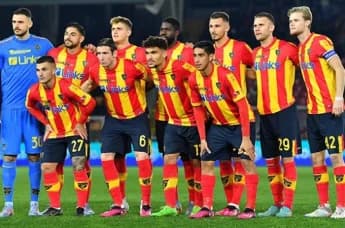From Golden Championships to Modern Battles – The Unbreakable Spirit of Germany’s Capital Club
Founded in 1892, Hertha Berliner Sport-Club (Hertha BSC) is one of Germany’s most historic and resilient football institutions. As Berlin's flagship club, Hertha has endured wars, political divisions, financial crises, and Bundesliga relegations—yet its blue-and-white heart continues to beat with undying passion.
From back-to-back German championships in the 1930s to Champions League nights at the Olympiastadion, Hertha’s legacy is etched into the fabric of German football. Despite recent struggles, including relegation in 2023, the club’s loyal fanbase, iconic stadium, and fierce rivalries remain a cultural pillar of Berlin.
A Club Born from a Steamboat: Hertha’s Early Glory
Founding & Pre-War Dominance (1892-1945)
-
Founded July 25, 1892 – Named after a steamship, Hertha, which founder Fritz Lindner had sailed on.
-
Early Berlin powerhouse – Dominated regional leagues before German football’s nationalization.
-
Golden Era (1930-31) – Won back-to-back German championships under coach Hans Tauchert, defeating Holstein Kiel (5-4) and 1860 Munich (3-2) in thrilling finals.
-
Nazi era struggles – Like many clubs, Hertha faced disruptions during WWII, with football taking a backseat to wartime chaos.
Cold War Survival & Bundesliga Founding Membership
Divided City, Divided Football (1945-1990)
-
West Berlin’s lone Bundesliga representative – While East Berlin had clubs like Union and Dynamo, Hertha became West Germany’s team in an isolated city.
-
1963: A Bundesliga pioneer – One of 16 founding members of the new unified league.
-
Scandal & relegation (1965) – Hertha was demoted due to a bribery scandal, tarnishing its reputation.
-
1970s resurgence – Under manager Georg Keßler, Hertha finished Bundesliga runners-up (1974-75) and reached the UEFA Cup semifinals (1979).
Reunification, Champions League Nights & Modern Struggles
Berlin’s Football Revival (1990-Present)
-
Post-reunification boom – With the Wall gone, Hertha became Berlin’s unifying club, though Union’s rise later split loyalties.
-
1997: Bundesliga return – After years in the second tier, Hertha stormed back under Falko Götz.
-
1999-2000: Champions League debut – Faced AC Milan, Chelsea, and Galatasaray, earning a famous 1-1 draw vs. Milan at the Olympiastadion.
-
2000s European pushes – Under Lucien Favre, Hertha became a Europa League regular, finishing 4th in 2008-09.
-
2010s instability – Relegations, promotions, and financial woes plagued the club despite big signings like Jhon Córdoba and Matheus Cunha.
-
2023: Bundesliga relegation – A disastrous season saw Hertha finish dead last, marking a new low—but the fans never wavered.
The Olympiastadion: Hertha’s Coliseum
A Historic Yet Challenging Home
-
Built for the 1936 Olympics – A Nazi-era monument transformed into a footballing temple.
-
74,475 capacity – One of Germany’s largest stadiums, but often too big for Hertha’s average crowds.
-
Atmosphere vs. practicality – Fans dream of a smaller, purpose-built stadium, but the Olympiastadion remains iconic.
-
Hosted 2006 World Cup & 2015 Champions League Final – Proof of its world-class status.
Derbies, Rivalries & Fan Culture
"Berliner Derby" vs. Union – A City Divided
-
Hertha (West) vs. Union (East) – More than football: a clash of ideologies, history, and identity.
-
First Bundesliga meeting (2019) – A 1-0 Union win that shook Berlin.
-
Fan culture contrast – Hertha’s traditional, broad support vs. Union’s working-class, rebel image.
Other Key Rivalries
-
Hamburger SV – A battle of Bundesliga founding giants.
-
Schalke 04 – Shared yo-yo club struggles in recent years.
-
Borussia Dortmund – High-profile clashes in European hunts.
The Faithful: Hertha’s Unshakeable Fanbase
"HaHoHe" – More Than a Chant, a Way of Life
-
Ostkurve madness – The standing terrace where ultras lead non-stop singing.
-
Anthem: "Nur nach Hause" – A Frank Zander classic belted before every game.
-
Loyalty through thick and thin – Even in 2. Bundesliga, 40,000+ fans pack the Olympiastadion.
-
Community work – Hertha’s foundation supports youth programs, anti-racism initiatives, and local charities.
The Future: Can Hertha Rise Again?
Rebuilding from the Ruins
-
Youth focus – Academy talents like Linus Gechter and Jonjoe Kenny must lead the revival.
-
Financial restructuring – After years of reckless spending, sustainability is key.
-
Promotion push – The 2023-24 2. Bundesliga campaign is a must-win.
-
Long-term vision – A new stadium? A return to Europe? The dream lives on.
Conclusion: A Club That Defies Time
Hertha BSC is Berlin’s footballing soul—a club that has survived wars, division, scandal, and relegation, yet still stands tall. Its history is unmatched, its fans are unbreakable, and its future, though uncertain, burns bright.
For Hertha, the only way is up. And when the blue-and-white rises again, all of Germany will hear it.
Founded in 1892, Hertha Berliner Sport-Club (Hertha BSC) is one of Germany’s most historic and resilient football institutions. As Berlin's flagship club, Hertha has endured wars, political divisions, financial crises, and Bundesliga relegations—yet its blue-and-white heart continues to beat with undying passion.
From back-to-back German championships in the 1930s to Champions League nights at the Olympiastadion, Hertha’s legacy is etched into the fabric of German football. Despite recent struggles, including relegation in 2023, the club’s loyal fanbase, iconic stadium, and fierce rivalries remain a cultural pillar of Berlin.
A Club Born from a Steamboat: Hertha’s Early Glory
Founding & Pre-War Dominance (1892-1945)
-
Founded July 25, 1892 – Named after a steamship, Hertha, which founder Fritz Lindner had sailed on.
-
Early Berlin powerhouse – Dominated regional leagues before German football’s nationalization.
-
Golden Era (1930-31) – Won back-to-back German championships under coach Hans Tauchert, defeating Holstein Kiel (5-4) and 1860 Munich (3-2) in thrilling finals.
-
Nazi era struggles – Like many clubs, Hertha faced disruptions during WWII, with football taking a backseat to wartime chaos.
Cold War Survival & Bundesliga Founding Membership
Divided City, Divided Football (1945-1990)
-
West Berlin’s lone Bundesliga representative – While East Berlin had clubs like Union and Dynamo, Hertha became West Germany’s team in an isolated city.
-
1963: A Bundesliga pioneer – One of 16 founding members of the new unified league.
-
Scandal & relegation (1965) – Hertha was demoted due to a bribery scandal, tarnishing its reputation.
-
1970s resurgence – Under manager Georg Keßler, Hertha finished Bundesliga runners-up (1974-75) and reached the UEFA Cup semifinals (1979).
Reunification, Champions League Nights & Modern Struggles
Berlin’s Football Revival (1990-Present)
-
Post-reunification boom – With the Wall gone, Hertha became Berlin’s unifying club, though Union’s rise later split loyalties.
-
1997: Bundesliga return – After years in the second tier, Hertha stormed back under Falko Götz.
-
1999-2000: Champions League debut – Faced AC Milan, Chelsea, and Galatasaray, earning a famous 1-1 draw vs. Milan at the Olympiastadion.
-
2000s European pushes – Under Lucien Favre, Hertha became a Europa League regular, finishing 4th in 2008-09.
-
2010s instability – Relegations, promotions, and financial woes plagued the club despite big signings like Jhon Córdoba and Matheus Cunha.
-
2023: Bundesliga relegation – A disastrous season saw Hertha finish dead last, marking a new low—but the fans never wavered.
The Olympiastadion: Hertha’s Coliseum
A Historic Yet Challenging Home
-
Built for the 1936 Olympics – A Nazi-era monument transformed into a footballing temple.
-
74,475 capacity – One of Germany’s largest stadiums, but often too big for Hertha’s average crowds.
-
Atmosphere vs. practicality – Fans dream of a smaller, purpose-built stadium, but the Olympiastadion remains iconic.
-
Hosted 2006 World Cup & 2015 Champions League Final – Proof of its world-class status.
Derbies, Rivalries & Fan Culture
"Berliner Derby" vs. Union – A City Divided
-
Hertha (West) vs. Union (East) – More than football: a clash of ideologies, history, and identity.
-
First Bundesliga meeting (2019) – A 1-0 Union win that shook Berlin.
-
Fan culture contrast – Hertha’s traditional, broad support vs. Union’s working-class, rebel image.
Other Key Rivalries
-
Hamburger SV – A battle of Bundesliga founding giants.
-
Schalke 04 – Shared yo-yo club struggles in recent years.
-
Borussia Dortmund – High-profile clashes in European hunts.
The Faithful: Hertha’s Unshakeable Fanbase
"HaHoHe" – More Than a Chant, a Way of Life
-
Ostkurve madness – The standing terrace where ultras lead non-stop singing.
-
Anthem: "Nur nach Hause" – A Frank Zander classic belted before every game.
-
Loyalty through thick and thin – Even in 2. Bundesliga, 40,000+ fans pack the Olympiastadion.
-
Community work – Hertha’s foundation supports youth programs, anti-racism initiatives, and local charities.
The Future: Can Hertha Rise Again?
Rebuilding from the Ruins
-
Youth focus – Academy talents like Linus Gechter and Jonjoe Kenny must lead the revival.
-
Financial restructuring – After years of reckless spending, sustainability is key.
-
Promotion push – The 2023-24 2. Bundesliga campaign is a must-win.
-
Long-term vision – A new stadium? A return to Europe? The dream lives on.
Conclusion: A Club That Defies Time
Hertha BSC is Berlin’s footballing soul—a club that has survived wars, division, scandal, and relegation, yet still stands tall. Its history is unmatched, its fans are unbreakable, and its future, though uncertain, burns bright.
For Hertha, the only way is up. And when the blue-and-white rises again, all of Germany will hear it.







